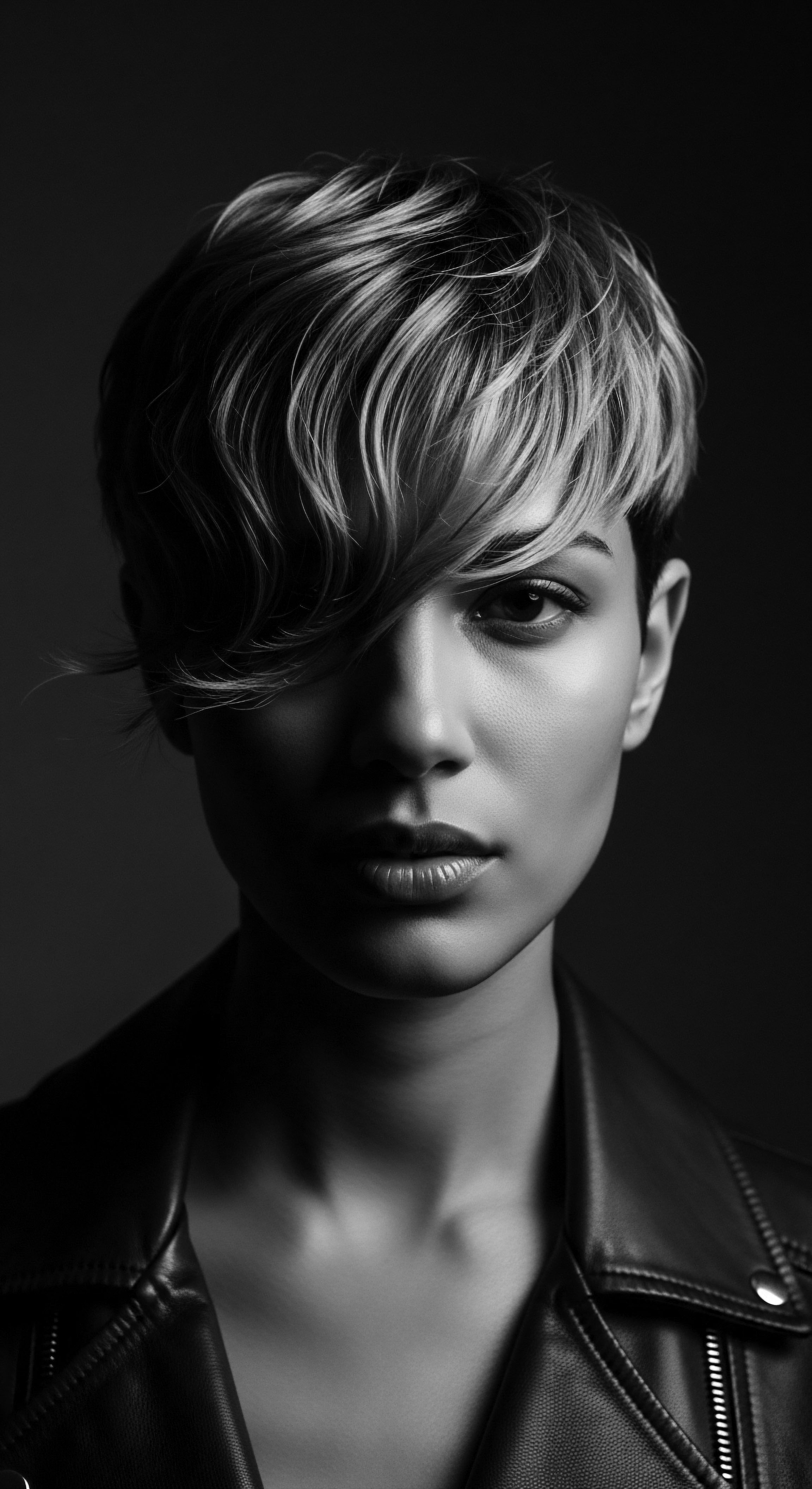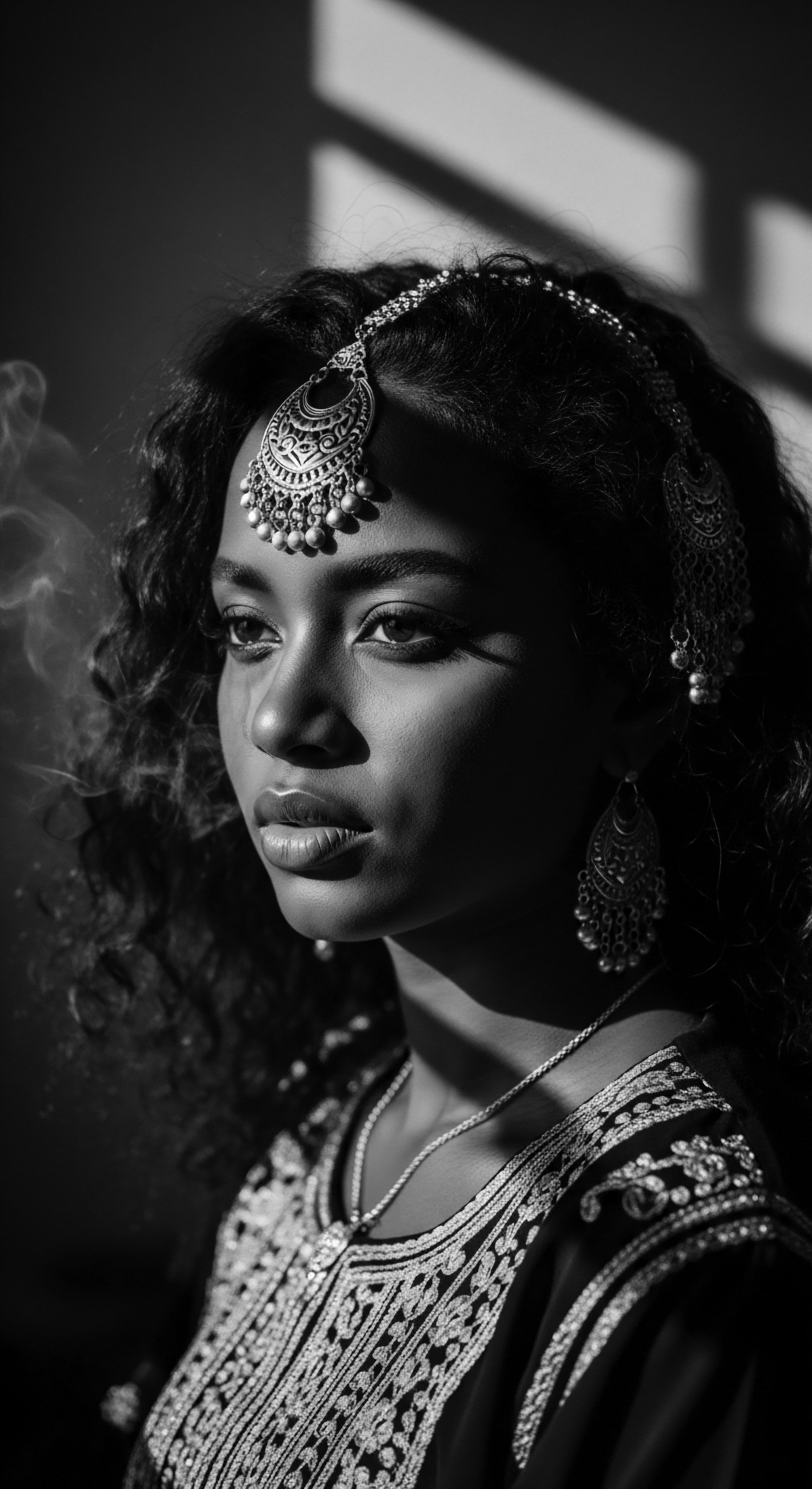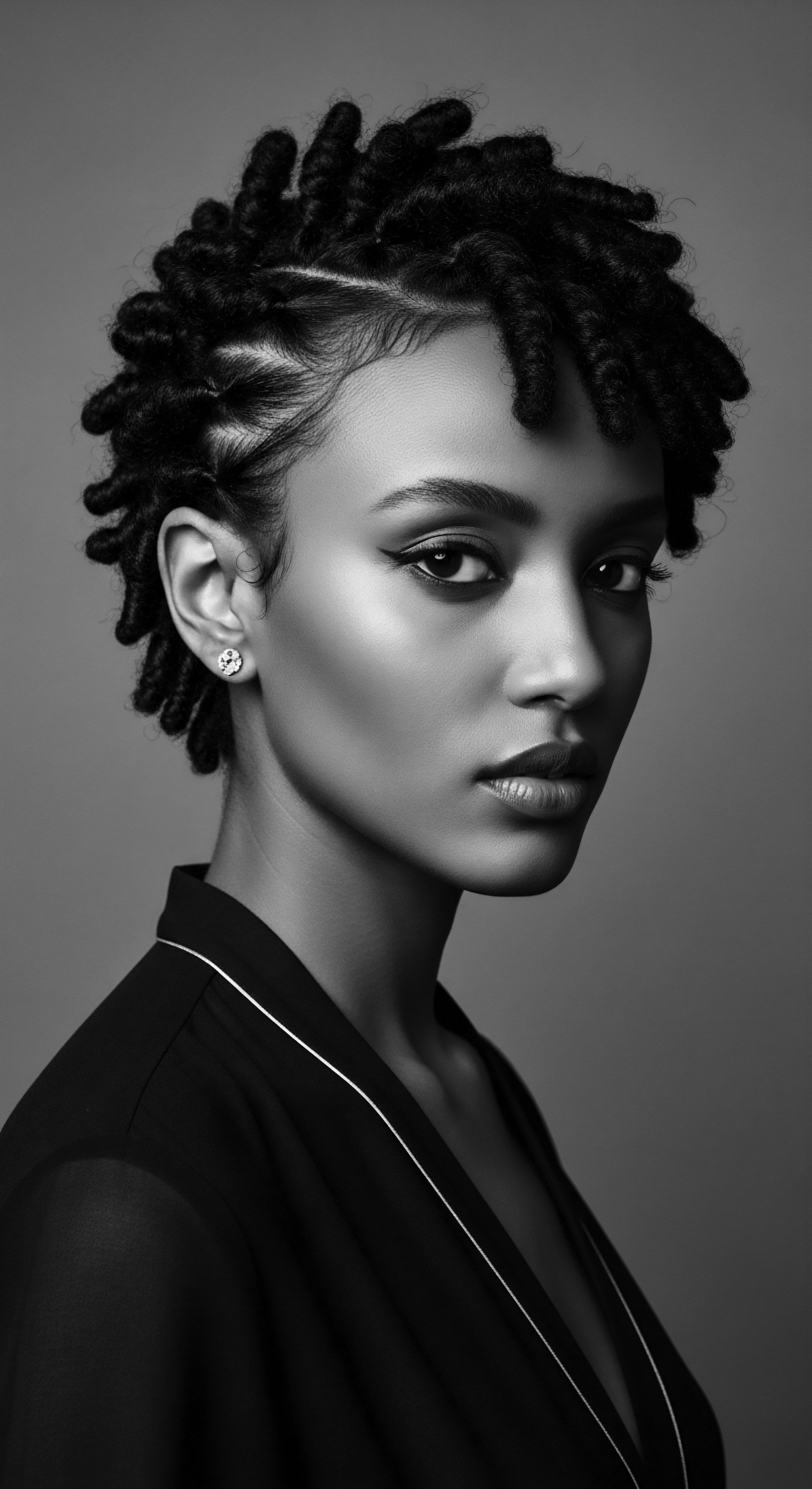
Roots
The story of textured hair is an ancestral chronicle, a living testament etched into each coil and wave. It begins not in a salon chair or a laboratory, but in the elemental biology of early peoples, across sun-drenched landscapes where strands evolved as a natural shield, a gift of resilience. This profound heritage shapes the very fibers we tend today, a whispered wisdom carried through generations.
How hair came to be, in its boundless forms across the global Black and mixed-race family, speaks to a magnificent biological artistry, intimately tied to the earliest human migrations and the environments encountered. We are not just caring for hair; we are engaging with an archive of ancient adaptive genius, a deep connection to the earth and the stories of our forebears.

Hair’s Earliest Protectors
To truly grasp how historical practices inform modern care, one must look to the very beginnings of human existence. The unique structure of coiled, kinky, and wavy hair provided vital protection against intense solar radiation, safeguarding the scalp and brain. This anatomical adaptation, often denser and more tightly curled, created a natural air barrier, insulating against both heat and cold. Our ancestors, living closely with their natural environments, inherently understood these protective qualities.
Their earliest methods of care, whether through gathering specific plant extracts or braiding patterns, arose from observing hair’s innate needs and its role in survival. These were not arbitrary acts; they were responses to climate, to community, to a collective well-being that included the health of one’s crown.
Textured hair’s anatomical design speaks to an ancient protective wisdom, influencing care practices from the dawn of humanity.

Ancestral Understanding of Fiber Structure
While modern science uses electron microscopes and molecular analysis, ancestral knowledge systems possessed a profound, intuitive understanding of hair’s fiber. They recognized its thirst for moisture, its vulnerability to breakage when dry, and its ability to shrink and expand. This observation-based wisdom led to practices designed to retain hydration and strengthen the hair shaft. For instance, the traditional use of various seed butters and oils, like the lauded shea butter , in West African communities provides a striking example.
Generations learned that rubbing the creamy extract of the shea nut onto hair imparted a lasting sheen and suppleness. This practice, documented in ethnobotanical studies, aligns with modern understanding of shea butter’s high content of fatty acids, such as oleic and stearic acids, which form a protective barrier on the hair, sealing in moisture and softening the strand (Masters, 2013). This rich history demonstrates how ancestral wisdom laid groundwork for present-day formulations, often without the scientific lexicon we now possess, but with an efficacy born of generations of shared wisdom.

Hair Classification Systems and Their Cultural Threads
The contemporary systems used to classify textured hair, while appearing scientific, often carry echoes of historical biases. However, within diverse Black communities, hair was often described not by numerical types, but by its appearance, its feel, its spirit. Terms might speak to its softness, its tenacity, its coil pattern, or its ability to hold a style. These cultural descriptions, passed down through oral traditions, reflected a more holistic appreciation for hair’s variety.
Understanding this historical context helps us approach modern classification with an awareness of its limitations and encourages a broader appreciation for the diverse expressions of textured hair within its heritage. It reminds us that every hair type is a unique chapter in a vast and beautiful ancestral book.

Does Hair Morphology Link to Deep History?
The very shape of the hair follicle—its elliptical or flat cross-section—is what gives textured hair its characteristic curl. This morphological distinction is deeply ancient, shaping not only how hair grows but also how it was perceived and cared for in historical contexts. Ancient Egyptian wall paintings depict intricately braided and styled hair, suggesting sophisticated care practices tailored to textured strands. The precise manipulation of coily hair into elaborate coiffures spoke to social status, tribal affiliation, and spiritual belief.
The need for gentle handling, specific detangling methods, and moisture retention, known intuitively by ancient stylists, arises directly from this unique morphology. The techniques they employed, such as careful sectioning and purposeful product application, mirror the core tenets of contemporary regimens, all stemming from the fundamental characteristic of the hair itself.
- Baobab Oil ❉ Extracted from the seeds of the baobab tree, this oil, historically used in various African communities, is rich in vitamins and fatty acids. It provides nourishment and sheen to hair, aiding in moisture retention for drier textures.
- Palm Oil ❉ A staple across West and Central Africa, red palm oil was traditionally incorporated into hair balms and scalp treatments. Its high vitamin E content supports hair health and helps maintain the scalp’s condition, connecting ancient dietary practices to external applications.
- Chebe Powder ❉ Originating from Chadian Basara Arab women, this mixture of local herbs and spices is traditionally used to strengthen hair and promote length retention. The practice involves coating the hair, allowing the powdered herbs to protect and condition the strands over extended periods.

Ritual
The act of tending textured hair has always transcended mere aesthetics; it has always been a profound ritual, a communicative art, a repository of heritage. From ancestral villages to modern urban centers, the hands that manipulate, braid, and adorn textured hair connect with a continuous lineage of ingenuity and cultural meaning. The techniques and tools passed down through generations are not simply methods; they embody stories of survival, identity, and artistic expression. Modern care, in its deepest sense, draws its vitality from these deeply rooted traditions, acknowledging the enduring power of a touch that speaks volumes.

The Protective Veil of Styling Heritage
Protective styling, a cornerstone of contemporary textured hair care, finds its most profound origins in ancestral practices. Braids, twists, and cornrows were not solely for adornment in many African societies; they served as vital indicators of age, marital status, tribal affiliation, and spiritual devotion. Beyond social signaling, these styles shielded hair from environmental damage, minimized manipulation, and allowed for sustained growth. The intricate art of cornrowing, for example, seen in sculptures and historical accounts from ancient Egypt to West African kingdoms, served as a foundational technique for managing coily hair.
The precision required, the sectioning, and the gentle tension applied to the hair roots – these are the same principles that guide modern protective styling to prevent breakage and promote length retention. The contemporary twist-out or braid-out is, in essence, a direct descendant of these long-standing, often ceremonial, styling traditions.
Protective styles, historically markers of identity, continue their legacy in modern care by preserving hair health.

Ancestral Tools and Their Modern Kin
The implements used in textured hair care, from simple bone combs to specialized needles for intricate braiding, have a long and storied heritage. Prior to mass production, tools were often crafted from natural materials – wood, bone, ivory, or plant fibers – and imbued with cultural significance. These tools were designed to navigate the unique characteristics of textured hair with respect and efficiency. For instance, the wide-toothed comb, now a common staple, mirrors the larger, often handmade combs of antiquity, which were better suited for detangling dense, coily strands without causing undue stress.
The act of detangling itself, a careful process of patience and tenderness, remains unchanged across centuries. The ancestral understanding of hair’s delicate nature dictated the design of these tools, a wisdom we now replicate with contemporary materials, but with the same core purpose ❉ gentle handling to preserve the strand’s integrity.
| Aspect Detangling |
| Historical/Ancestral Practice Finger detangling, wide-tooth combs crafted from wood or bone, application of natural oils or water to add slip. |
| Modern Care Connection Pre-pooing with oils, detangling conditioners, wide-tooth combs and brushes with flexible bristles, sectioning hair before detangling. |
| Aspect Moisture Retention |
| Historical/Ancestral Practice Application of natural butters (e.g. shea, cocoa), plant oils (e.g. palm, castor), headwraps to protect from elements. |
| Modern Care Connection Use of leave-in conditioners, creams, oils (LOC/LCO method), humectants, sealed ends, silk/satin bonnets and pillowcases. |
| Aspect Hair Cleansing |
| Historical/Ancestral Practice Use of saponifying plant materials (e.g. soap berries, aloe vera pulp), clay, or natural acids (e.g. fermented rice water). |
| Modern Care Connection Sulfate-free shampoos, co-washing, clarifying treatments, scalp detoxes, natural cleansing alternatives. |
| Aspect The continuum of care highlights an ongoing dedication to moisture, gentle handling, and protection, echoing ancient wisdom. |

Ancestral Hair Threading
Consider the ancestral technique of hair threading or ‘banding’, which involves wrapping sections of hair tightly with thread or string. This method, long practiced in diverse African cultures, was a highly effective way to stretch and elongate coily hair without the need for heat. It helped to maintain the hair’s length, protect the ends from breakage, and prepare the hair for further styling. This historical practice directly parallels modern heatless stretching methods such as banding, African threading, or roller sets, which seek to achieve similar results while prioritizing hair health.
The careful manipulation and tension applied to the hair fiber in traditional threading speaks to an innate understanding of how to alter the curl pattern temporarily without compromising the structural integrity of the strand. This ancestral ingenuity continues to guide contemporary stylists seeking gentle alternatives for hair elongation.

How Do Traditional Styling Practices Inform Present-Day Trends?
Many contemporary styling trends for textured hair draw directly from historical and ancestral practices. Braids of all kinds, whether box braids, cornrows, or micro braids, retain their protective qualities and cultural significance while adapting to modern aesthetics. Twists and coils, achieved through finger-styling or two-strand twists, echo ancestral methods of creating definition and elongation. Even the contemporary popularity of hair extensions and wigs finds precedent in historical adornment.
In ancient Egypt, wigs were worn by both men and women for status, hygiene, and aesthetic appeal. In various African societies, hair attachments, often made from natural fibers or human hair, were used to signify tribal identity, wealth, or ceremonial readiness. These practices demonstrate a continuous thread of hair artistry and its social function, linking past expressions to present-day sartorial choices.

Relay
The relay of textured hair care, from ancient practices to today’s routines, represents a living chain of ancestral wisdom, refined and reinterpreted through generations. It is a dialogue between the historical inclination towards holistic well-being and the scientific lens of contemporary understanding. This continuous exchange honors the deep connection between hair health, self-reverence, and communal identity, ensuring that the legacy of care remains vibrant and relevant for every strand.

Nurturing from Within and Without
Holistic care for textured hair is a concept deeply rooted in ancestral wellness philosophies. These traditions understood that true hair vitality stemmed not only from external applications but also from internal nourishment and spiritual alignment. Dietary practices, often centered around nutrient-dense foods abundant in local ecosystems, were considered integral to hair strength and sheen. For instance, diets rich in fruits, vegetables, and lean proteins, common in many traditional African diets, naturally provided the vitamins and minerals (like iron, zinc, and vitamin A) essential for healthy hair growth.
Modern nutritional science now validates these ancestral food wisdoms, affirming the link between a balanced diet and robust hair follicles. This continuity underscores a timeless truth ❉ hair health is a reflection of overall well-being, a concept passed down through the ages.
Holistic hair care, rooted in ancestral traditions, honors the connection between internal health and outward vitality.

The Nighttime Sanctuary
The practice of covering hair at night, now widely recognized as essential for protecting textured strands, holds a profound historical lineage. From elaborate headwraps worn during the day for cultural and religious reasons to simpler coverings for sleep, the act of wrapping the hair safeguarded it from environmental elements and prevented tangling. The modern silk or satin bonnet and pillowcase are direct descendants of this protective tradition. The use of smooth fabrics was intuitively understood to reduce friction, which can lead to breakage and frizz for delicate textured hair.
This ancestral wisdom, prioritizing hair’s integrity during rest, speaks to a consistent, generational understanding of the specific needs of coily and curly hair. It was, and remains, a sacred ritual that preserves the crown.
Beyond the physical protection, the nighttime ritual often carried a deeper cultural weight. For many Black women, the headwrap or bonnet became a symbol of self-care, a private moment of preservation away from external gaze. This quiet act of tending to one’s hair before sleep became a practice of self-love and continuity with lineage, a silent acknowledgment of the strength and beauty inherited. The seemingly simple bonnet therefore carries centuries of meaning, a quiet declaration of self-worth and hair preservation.

Ancestral Ingredients in Modern Formulations
Many of the most popular and effective ingredients in modern textured hair products have a direct lineage to ancestral remedies. Consider the widespread use of castor oil , particularly black castor oil, which has a long history in African and Caribbean communities. Traditionally, it was prepared through a painstaking process of roasting, grinding, and boiling castor beans, yielding a thick, dark oil prized for its perceived ability to strengthen hair, promote growth, and address scalp ailments. Contemporary scientific analysis of castor oil reveals its richness in ricinoleic acid, a fatty acid with anti-inflammatory properties that may contribute to scalp health and thereby indirectly support hair growth.
The efficacy observed by generations of practitioners is now being explained by modern chemistry, bridging centuries of empirical knowledge with current scientific understanding. Similarly, the widespread usage of aloe vera, known for its soothing and moisturizing properties, dates back to ancient Egyptian times, where it was considered a sacred plant for various medicinal and cosmetic purposes, including hair health. This botanical heritage underpins many modern formulas, proving that some wisdom endures the test of time and research.

How Do Traditional Solutions Inform Current Problem Solving?
Many common hair concerns faced by textured hair wearers today—dryness, breakage, lack of growth, and scalp issues—were also challenges for our ancestors. Their solutions, born of observation and resourcefulness, often relied on natural elements. For example, issues of extreme dryness might have been addressed by creating rich hair masks from fermented rice water, a practice seen in ancient East Asian cultures that also has parallels in some African traditions, or by applying thick poultices of plant extracts. Scalp irritation might have been soothed with anti-inflammatory herbs or natural clays.
Modern hair problem-solving draws heavily from these foundational approaches. We now seek out products with moisturizing ingredients, protein treatments to fortify weak strands, and scalp treatments with botanical extracts. While the delivery mechanisms and concentrations have evolved, the underlying principles of nourishing, strengthening, and soothing remain consistent, a continuous thread of wisdom from past to present.

Reflection
The journey through the textured hair heritage, from the fundamental structure of the strand to the intricate rituals of care and the enduring legacy of ancestral wisdom, reveals a narrative far richer than mere beauty. It is a profound meditation on identity, resilience, and the power of inherited knowledge. Each coil, each twist, each thoughtful application of a balm carries within it the echoes of countless generations who understood, protected, and celebrated this unique aspect of their being. The modern care practices we employ today are not isolated innovations; they are vibrant continuations of an ancient lineage, a living, breathing archive of hair artistry and communal wisdom.
Roothea’s ‘Soul of a Strand’ ethos recognizes this inherent connection, seeking to honor the deep past while looking toward a future where textured hair is universally understood, valued, and revered. It is about understanding that when we care for our hair, we are participating in a timeless dialogue, a heritage passed down through touch, story, and tradition. The answers to how historical textured hair practices connect to modern care reside within this enduring legacy, inviting us to treat each strand as a sacred thread in the grand, continuous narrative of human beauty and cultural strength.

References
- Byrd, A. D. & Tharps, L. L. (2014). Hair Story ❉ Untangling the Roots of Black Hair in America. St. Martin’s Press.
- Kalu, O. (2001). The African Church ❉ Its History and Identity. Africa World Press.
- Lovejoy, P. E. (2012). Transformations in Slavery ❉ A History of Slavery in Africa. Cambridge University Press.
- Masters, S. (2013). The Shea Butter Handbook ❉ A Comprehensive Guide to the Natural Wonder of Shea Butter. Createspace Independent Publishing Platform.
- Opoku, A. A. (1978). West African Traditional Religion. FEP International Private Limited.
- Perkins, W. E. (1996). African Americans and the Hair Industry ❉ The Black Hair Culture. Praeger.
- Sieber, R. & Herreman, N. (2000). Hair in African Art and Culture. Museum for African Art.
- Walker, A. (2001). The History of Black Hair ❉ From Ancient Times to Today. African American Images.
